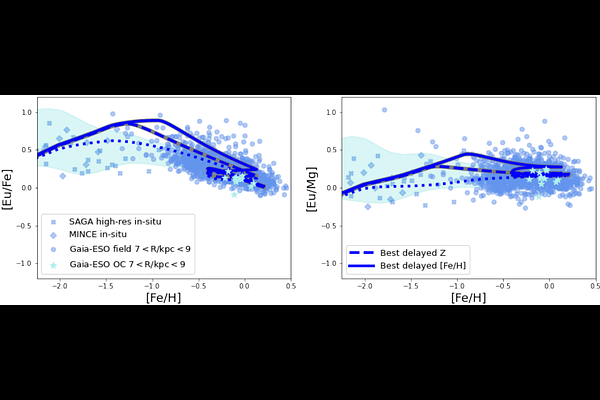Europium, we have a problem. Modelling r-process enrichment across Local Group galaxies

Europium, we have a problem. Modelling r-process enrichment across Local Group galaxies
Marco Palla, Marta Molero, Donatella Romano, Alessio Mucciarelli
AbstractContext: Europium (Eu) serves as a crucial tracer to understand the origin of rapid neutron-capture process (r-process) elements. An extensive effort was made in the last decade to model the chemical evolution of this element in the Galaxy. However, less attention was reserved to Eu in different galaxies of the Local Group (LG). Aims: By employing detailed and well-tested chemical evolution models, we investigate Eu enrichment across LG dwarf spheroidal galaxies, allowing for a direct comparison between model predictions for dwarf galaxies and the Milky Way (MW). Methods: Building upon an r-process enrichment framework that successfully reproduces the observed Eu abundance patterns as well as the supernova and compact binary merger rates in the MW, we build chemical evolution models for the Sagittarius, Fornax, and Sculptor dwarf spheroidal galaxies and test the enrichment scenario against the abundance patterns observed in these galaxies. Results: Models reproducing the Galactic Eu patterns significantly underestimate the [Eu/Fe] ratios observed in LG dwarfs. To address this "missing Eu" problem, we estimate the Eu production rate needed to match the observations and explore potential contributions either from prompt or delayed sources, assessing their compatibility with the MW observables. Conclusions: The same r-process enrichment frameworks cannot reproduce simultaneously the Eu patterns both in the MW and in dwarf galaxies. However, a scenario where additional Eu is provided by an increased production from delayed sources at low metallicity can theoretically reconcile the trends observed in the MW and in LG dwarfs, because of the small discrepancies (0.1 dex) between model predictions and observations found in this case. Further targeting and modelling of neutron-capture elements in LG galaxies are however needed to fill the gaps in our current understanding of the problem.